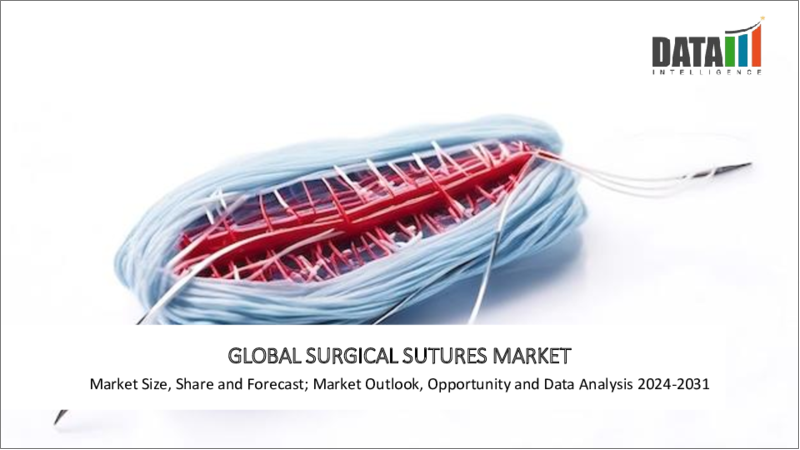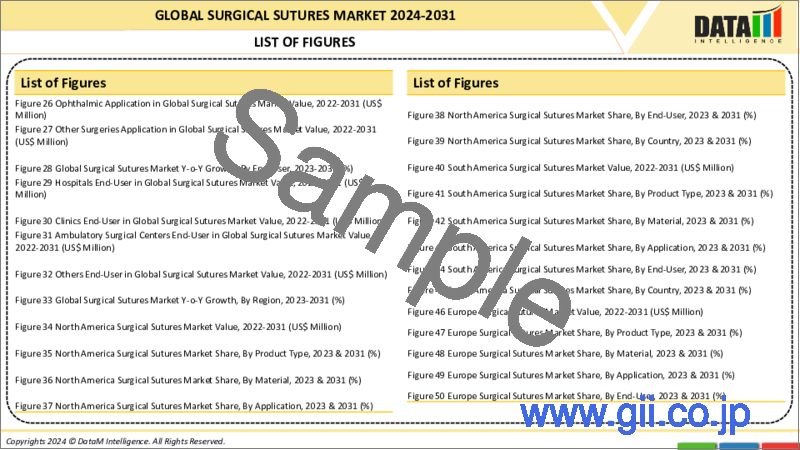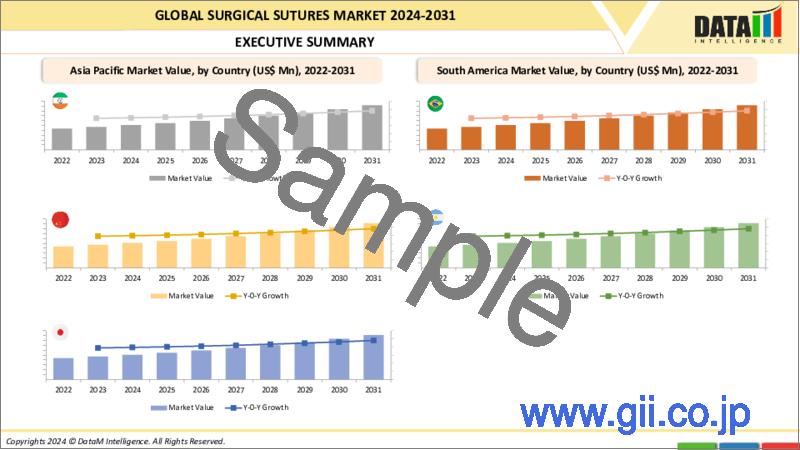|
|
市場調査レポート
商品コード
1316302
手術用縫合糸の世界市場-2023年~2030年Global Surgical Sutures Market - 2023-2030 |
||||||
カスタマイズ可能
適宜更新あり
|
|||||||
| 手術用縫合糸の世界市場-2023年~2030年 |
|
出版日: 2023年07月27日
発行: DataM Intelligence
ページ情報: 英文 195 Pages
納期: 即日から翌営業日
|
- 全表示
- 概要
- 目次
市場概要
世界の手術用縫合糸市場は2022年に43億米ドルに達し、2030年には69億米ドルに達するなど、有利な成長が予測されています。世界の手術用縫合糸市場は、予測期間(2023~2030年)にCAGR 6.2%を示すと予測されています。
外科用縫合糸は、損傷後に血管を結紮し、損傷した組織を修復するために使用される医療用のストランドまたは糸です。絹などの天然繊維やナイロン、ポリエステルなどの合成繊維が使用されます。比類のない引張強度、柔軟性、無菌性、結び目の安全性を備えています。
手術に応じて、さまざまなサイズ、種類、形状、糸の材質を簡単に利用できます。現在、複数のメーカーが合成モノフィラメントのポリジオキサノン縫合糸(PDS)を提供しており、軟組織創傷の治療や小児心臓手術時の腹部閉鎖に広く使用されています。
市場動向
手術件数の増加が市場成長を牽引
患者の手術件数の増加に伴い、医療業界における手術用縫合糸の需要も増加しています。ヘルスケア事業が改善された結果、治療アプローチの改良が進み、市場成長が促進される可能性が高いです。
例えば、NLMによると、世界全体では毎年、米国で約4,000万~5,000万件、欧州で約2,000万件の大手術が行われています。これらの患者のうち1~4%が死亡し、最大15%が重度の術後罹患を経験し、5~15%が30日以内に再入院すると予想されています。世界の年間死亡率は約800万人で、大手術は心臓血管疾患や脳卒中、がん、事故などの上位死因に匹敵します。
最先端技術の導入が市場成長を牽引
高度な外科治療に対する意識の高まりにより、市場参加者は研究開発に重点を置き、新しく革新的な商品を市場に導入する必要に迫られています。さらに、新しく改良された自動縫合糸の流入が増えているため、世界中の外科医の間でこれらの装置に対する嗜好が高まっています。
例えば、2021年03月03日、Origami Surgicalは、外科医が個々のロボット支援縫合要件に適応した追加のStitchKitデバイスを使用できるようにする、次の技術プラットフォームの承認を発表しました。この新プラットフォームは、1台のStitchKit装置で、様々な吸収性・非吸収性縫合材料を提供します。その結果、前述の要因が市場拡大に寄与しています。
手術用縫合糸の副作用が市場成長の妨げになる
手術用縫合糸は皮膚や組織に刺し傷を作るため、感染のリスクが高まる可能性があります。縫合部位から細菌が体内に侵入し、局所感染や全身感染を引き起こす可能性があります。このリスクを最小限に抑えるためには、適切な滅菌手技と術後のケアが重要です。
縫合糸に対してアレルギー反応や炎症反応を起こす人もいます。これは発赤、腫脹、疼痛、創傷治癒の遅延につながる可能性があります。過敏症であることが分かっている人には、代替材料から作られた縫合糸を使用するか、吸収性縫合糸を選択する必要があるかもしれません。このように、手術用縫合糸の影響は市場成長の妨げとなります。
COVID-19影響分析
COVID-19の蔓延を防ぐために世界中で一般外科手術の稼働時間が制限されているため、パンデミックは手術用縫合糸分野に悪影響を及ぼしています。さらに、重要なスタッフの不足により、世界中のさまざまな病院で複数の診療科が閉鎖されたため、COVID-19以外の患者に勧められる手術の数が減少しました。
さらに、COVID-19患者は、自分の治療に重要な資源を投入するために急ぐことが予想されます。この結果、世界中の人々が選択的治療の延期を余儀なくされています。さらに、一般外科手術の減少は手術用縫合糸の市場にも悪影響を及ぼしています。
ロシア・ウクライナ紛争の影響分析
ロシアとウクライナの紛争は、この地域の主要市場プレーヤーの数が少ないことから、世界の手術用縫合糸市場に与える影響は中程度と推定されます。しかし、原材料の輸出入の影響は、予測期間中、世界の手術用縫合糸市場の成長にほとんど影響を与えないと予想されます。
目次
第1章 調査手法と調査範囲
第2章 定義と概要
第3章 エグゼクティブサマリー
第4章 市場力学
- 影響要因
- 促進要因
- 事故件数の増加
- 抑制要因
- 高度な創傷閉鎖手段に対する需要の高まり
- 機会
- 新興市場における患者数の増加
- 影響分析
- 促進要因
第5章 産業分析
- ポーターの5フォース分析
- サプライチェーン分析
- 価格分析
- 規制分析
第6章 COVID-19分析
第7章 製品タイプ別
- 吸収性
- 非吸収性
第8章 用途別
- 心臓血管
- 一般
- 婦人科
- 整形外科
- 眼科
- その他
第9章 エンドユーザー別
- 病院
- クリニック
- 外来手術センター
- その他
第10章 地域別
- 北米
- 米国
- カナダ
- メキシコ
- 欧州
- ドイツ
- 英国
- フランス
- スペイン
- イタリア
- その他欧州
- 南米
- ブラジル
- アルゼンチン
- その他南米
- アジア太平洋
- 中国
- インド
- 日本
- その他アジア太平洋地域
- 中東およびアフリカ
- 主な地域別ダイナミクス
第11章 競合情勢
- 競合シナリオ
- 市況/シェア分析
- M&A分析
第12章 企業プロファイル
- Ethicon, Inc
- 会社概要
- 製品ポートフォリオと説明
- 財務概要
- 主な発展
- Medtronic plc
- B.Braun Melsungen AG
- Smith& Nephew plc
- Boston Scientific Corporation
- Peters Surgical
- DemeTECH Corporation
- Internacional Farmaceutica
- Sutures India
- Integra Lifesciences.
第13章 付録
Market Overview
The global surgical sutures market reached US$ 4.3 billion in 2022 and is projected to witness lucrative growth by reaching up to US$ 6.9 billion by 2030. The global surgical sutures market is expected to exhibit a CAGR of 6.2% during the forecast period (2023-2030).
Surgical sutures are medical strands or threads that are used after an injury to ligate blood vessels and repair damaged tissues together. Natural fibres such as silk are used, as are synthetic materials like as nylon and polyester. They have tensile strength, flexibility, sterility, and knot security that are unrivalled.
Depending on the surgery, they are readily accessible in a variety of sizes, types, forms, and thread materials. Several manufacturers are currently offering synthetic monofilament polydioxanone sutures (PDS), which are widely used in the treatment of soft-tissue wounds and abdominal closures during paediatric cardiac operations.
MarketDynamics
Increase in the Number of Surgeries Will Drive the Market Growth
As the number of surgical procedures done on patients increases, so does the demand for surgical sutures in the medical industry. As a result of improvements in the healthcare business, improved treatment approaches are being created, which is likely to enhance market growth.
For instance, according to NLM, globally, every year, around 40 to 50 million major procedures are performed in the United States and 20 million in Europe. It is expected that 1-4% of these patients may die, up to 15% will experience severe postoperative morbidity, and 5-15% will be readmitted within 30 days. With an annual global mortality rate of roughly 8 million patients, major surgery is on par with the top causes of death, which include cardiovascular disease and stroke, cancer, and accident.
Introduction of Technologically Advanced Devices to Drive the Market Growth
Growing awareness of advanced surgical treatments is forcing market participants to place a high emphasis on R&D and to introduce new and innovative goods to the market. Furthermore, the increasing influx of new and improved automated sutures has resulted in a growing preference for these devices among surgeons worldwide.
For instance, March 03, 2021, Origami Surgical has announced the approval of its next technology platform, which will enable surgeons with additional StitchKit devices adapted to their individual robotic-assisted suturing requirements. Within a single StitchKit device, the new platform offers a variety of absorbable and non-absorbable suture materials. As a result, the aforementioned factors contribute to market expansion.
Adverse Effects of Surgical Sutures will Hamper the Market Growth
Surgical sutures create puncture wounds in the skin or tissues, which can increase the risk of infection. Bacteria can enter the body through the suture site and cause localized or systemic infections. Proper sterile technique and post-operative care are crucial to minimize this risk.
Some individuals may experience an allergic or inflammatory reaction to the suture material. This can lead to redness, swelling, pain, or delayed wound healing. Using sutures made from alternative materials or opting for absorbable sutures may be necessary for individuals with known sensitivities. Thus effects of surgical suture will hamper the market growth.
COVID-19 Impact Analysis
Due to restrictions put on general surgical procedure operating hours around the world to prevent the spread of COVID-19, the pandemic has had a detrimental impact on the surgical suture sector. Furthermore, the closure of multiple departments at various hospitals throughout the world due to a lack of critical staff has reduced the number of procedures advised to non-COVID-19 patients.
Furthermore, COVID-19 patients are expected to rush to commit critical resources to their care. People all across the world have been forced to postpone elective treatments as a result of this. Furthermore, fewer general surgical procedures have a negative influence on the market for surgical sutures.
Russia-Ukraine War Impact Analysis
The Russia-Ukraine conflict is estimated to have a moderate impact on the global surgical sutures market, owing to the low number of key market players in this region. However, the impact of the import and export of raw materials is expected to have little influence over the global Surgical Suturesmarket growth over the forecast period.
Segment Analysis
The global surgical sutures market is segmented based on infection product type, application, end user and region.
Orthopaedic surgery Type Segment Accounts for 28.3% of Market Share
The orthopaedic surgery segment is expected to expand and ankle and foot fractures are among the most common types of injuries treated by orthopaedic teams around the world. Suture materials used in orthopaedic surgery are used to close wounds and heal fascia, muscles, tendons, ligaments, joint capsules, and cerclage or tension band of certain fractures.
The rise of accidents will helps to drive the market growth. For instance, according to CDC, every year, 1.35 million people are killed on the world's roads. Every day, about 3,700 people are killed in automobile, bus, motorcycle, bicycle, truck, or pedestrian accidents around the world. Pedestrians, motorcyclists, and cyclists account for more than half of those fatalities.
These rising numbers of injuries mostly contribute to soft tissue injury, particularly tendons, creating a need for more orthopaedic closure procedures. As a result, the orthopaedic surgery category is predicted to increase rapidly throughout the projection period.
Geographical Analysis
Asia Pacific Accounted for Approximately 25.7% of the Market Share
Due to increased activity by leading market players in the region's countries. For instance, on January 4, 2023, MiMedx Group, Inc., a pioneer and industry leader in placental biologics, struck into an exclusive distribution deal with Gunze Medical Limited, a branch of Gunze Limited, for the sale of EPIFIX in Japan. Gunze Medical is a well-known manufacturer of bioabsorbable devices and materials, such as sutures and sheet products, used in a variety of surgical and wound care settings.
In addition to a nationwide network of over 90 sales representatives and clinical support personnel, the organisation has strong relationships with current clinicians. Thus above factors shows the growth of the region.
Competitive Landscape
The major global players in the surgical sutures market: Ethicon, Inc, Medtronic plc, B.Braun Melsungen AG, Smith& Nephew plc, Boston Scientific Corporation, Peters Surgical, DemeTECH Corporation, Internacional Farmaceutica, Sutures India, Integra Lifesciences and among others.
Why Purchase the Report?
- To visualize the global surgical sutures market segmentation based on product type, application, end user and region, as well as understand key commercial assets and players.
- Identify commercial opportunities by analyzing trends and co-development.
- Excel data sheet with numerous data points of surgical sutures market-level with all segments.
- PDF report consists of a comprehensive analysis after exhaustive qualitative interviews and an in-depth study.
- Product mapping available as excel consisting of key products of all the major players.
The global surgical sutures market report would provide approximately 53 tables, 54 figures and 195 Pages.
Target Audience 2023
- Manufacturers/ Buyers
- Industry Investors/Investment Bankers
- Research Professionals
- Emerging Companies
Table of Contents
1. Methodology and Scope
- 1.1. Research Methodology
- 1.2. Research Objective and Scope of the Report
2. Definition and Overview
3. Executive Summary
- 3.1. Snippet by Product Type
- 3.2. Snippet by Application
- 3.3. Snippet by End User
- 3.4. Snippet by Region
4. Dynamics
- 4.1. Impacting Factors
- 4.1.1. Drivers
- 4.1.1.1. Increase in the number of accidents
- 4.1.1.2. Introduction of technologically advanced devices
- 4.1.2. Restraints
- 4.1.2.1. Growing demand for advanced wound closure alternatives
- 4.1.3. Opportunity
- 4.1.3.1. Growing patient population in emerging markets
- 4.1.4. Impact Analysis
- 4.1.1. Drivers
5. Industry Analysis
- 5.1. Porter's 5 Forces Analysis
- 5.2. Supply Chain Analysis
- 5.3. Pricing Analysis
- 5.4. Regulatory Analysis
6. COVID-19 Analysis
- 6.1. Analysis of COVID-19
- 6.1.1. Scenario Before COVID-19
- 6.1.2. Scenario During COVID-19
- 6.1.3. Scenario Post COVID-19
- 6.2. Pricing Dynamics Amid COVID-19
- 6.3. Demand-Supply Spectrum
- 6.4. Government Initiatives Related to the Market During Pandemic
- 6.5. Manufacturers Strategic Initiatives
- 6.6. Conclusion
7. By Product Type
- 7.1. Introduction
- 7.1.1. Market Size Analysis and Y-o-Y Growth Analysis (%), By Product Type
- 7.1.2. Market Attractiveness Index, By Product Type
- 7.2. Absorbable*
- 7.2.1. Introduction
- 7.2.2. Market Size Analysis and Y-o-Y Growth Analysis (%)
- 7.3. Non-Absorbable
8. By Application
- 8.1. Introduction
- 8.1.1. Market Size Analysis and Y-o-Y Growth Analysis (%), By Application
- 8.1.2. Market Attractiveness Index, By Application
- 8.2. Cardiovascular*
- 8.2.1. Introduction
- 8.2.2. Market Size Analysis and Y-o-Y Growth Analysis (%)
- 8.3. General
- 8.4. Gynecological
- 8.5. Orthopedic
- 8.6. Ophthalmic
- 8.7. Other Surgeries
9. By End User
- 9.1. Introduction
- 9.1.1. Market Size Analysis and Y-o-Y Growth Analysis (%), By End User
- 9.1.2. Market Attractiveness Index, By End User
- 9.2. Hospitals*
- 9.2.1. Introduction
- 9.2.2. Market Size Analysis and Y-o-Y Growth Analysis (%)
- 9.3. Clinics
- 9.4. Ambulatory Surgical Centers
- 9.5. Others
10. By Region
- 10.1. Introduction
- 10.1.1. Market Size Analysis and Y-o-Y Growth Analysis (%), By Region
- 10.1.2. Market Attractiveness Index, By Region
- 10.2. North America
- 10.2.1. Introduction
- 10.2.2. Key Region-Specific Dynamics
- 10.2.3. Market Size Analysis and Y-o-Y Growth Analysis (%), By Product Type
- 10.2.4. Market Size Analysis and Y-o-Y Growth Analysis (%), By Application
- 10.2.5. Market Size Analysis and Y-o-Y Growth Analysis (%), By End User
- 10.2.6. Market Size Analysis and Y-o-Y Growth Analysis (%), By Country
- 10.2.6.1. U.S.
- 10.2.6.2. Canada
- 10.2.6.3. Mexico
- 10.3. Europe
- 10.3.1. Introduction
- 10.3.2. Key Region-Specific Dynamics
- 10.3.3. Market Size Analysis and Y-o-Y Growth Analysis (%), By Product Type
- 10.3.4. Market Size Analysis and Y-o-Y Growth Analysis (%), By Application
- 10.3.5. Market Size Analysis and Y-o-Y Growth Analysis (%), By End User
- 10.3.6. Market Size Analysis and Y-o-Y Growth Analysis (%), By Country
- 10.3.6.1. Germany
- 10.3.6.2. U.K.
- 10.3.6.3. France
- 10.3.6.4. Spain
- 10.3.6.5. Italy
- 10.3.6.6. Rest of Europe
- 10.4. South America
- 10.4.1. Introduction
- 10.4.2. Key Region-Specific Dynamics
- 10.4.3. Market Size Analysis and Y-o-Y Growth Analysis (%), By Product Type
- 10.4.4. Market Size Analysis and Y-o-Y Growth Analysis (%), By Application
- 10.4.5. Market Size Analysis and Y-o-Y Growth Analysis (%), By End User
- 10.4.6. Market Size Analysis and Y-o-Y Growth Analysis (%), By Country
- 10.4.6.1. Brazil
- 10.4.6.2. Argentina
- 10.4.6.3. Rest of South America
- 10.5. Asia-Pacific
- 10.5.1. Introduction
- 10.5.2. Key Region-Specific Dynamics
- 10.5.3. Market Size Analysis and Y-o-Y Growth Analysis (%), By Product Type
- 10.5.4. Market Size Analysis and Y-o-Y Growth Analysis (%), By Application
- 10.5.5. Market Size Analysis and Y-o-Y Growth Analysis (%), By End User
- 10.5.6. Market Size Analysis and Y-o-Y Growth Analysis (%), By Country
- 10.5.6.1. China
- 10.5.6.2. India
- 10.5.6.3. Japan
Australia
- 10.5.6.4. Rest of Asia-Pacific
- 10.6. Middle East and Africa
- 10.6.1. Introduction
- 10.6.2. Key Region-Specific Dynamics
- 10.6.3. Market Size Analysis and Y-o-Y Growth Analysis (%), By Product Type
- 10.6.4. Market Size Analysis and Y-o-Y Growth Analysis (%), By Application
- 10.6.5. Market Size Analysis and Y-o-Y Growth Analysis (%), By End User
- 10.6.6. Market Size Analysis and Y-o-Y Growth Analysis (%), By Distribution Channel
11. Competitive Landscape
- 11.1. Competitive Scenario
- 11.2. Market Positioning/Share Analysis
- 11.3. Mergers and Acquisitions Analysis
12. Company Profiles
- 12.1. Ethicon, Inc*
- 12.1.1. Company Overview
- 12.1.2. Product Portfolio and Description
- 12.1.3. Financial Overview
- 12.1.4. Key Developments
- 12.2. Medtronic plc
- 12.3. B.Braun Melsungen AG
- 12.4. Smith& Nephew plc
- 12.5. Boston Scientific Corporation
- 12.6. Peters Surgical
- 12.7. DemeTECH Corporation
- 12.8. Internacional Farmaceutica
- 12.9. Sutures India
- 12.10. Integra Lifesciences.
LIST NOT EXHAUSTIVE
13. Appendix
- 13.1. About Us and Services
- 13.2. Contact Us






